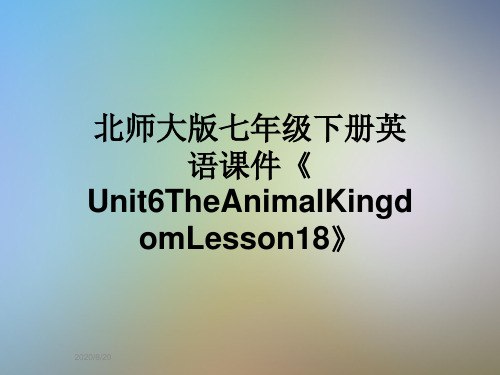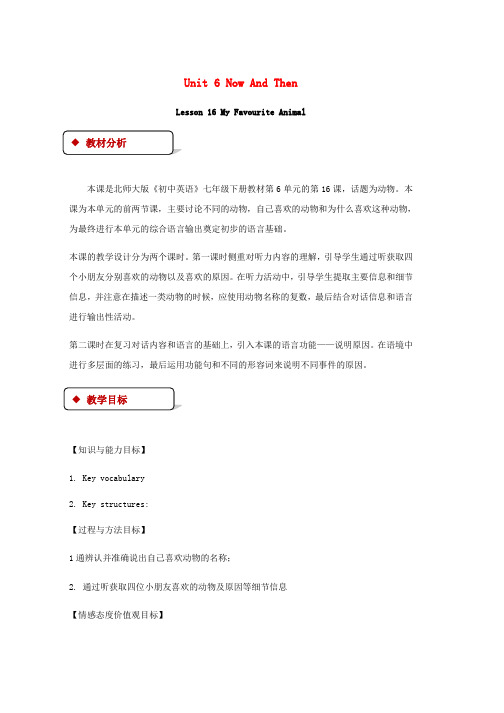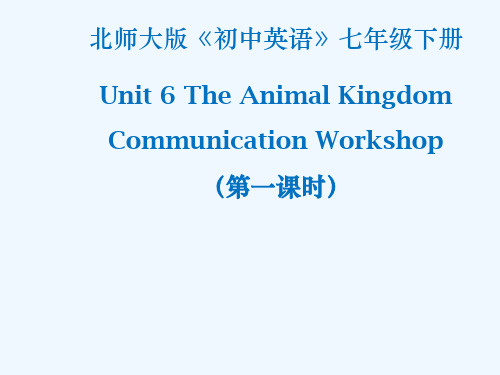北师大版英语七下Unit 6《The Animal Kingdom》word单元测试卷
- 格式:doc
- 大小:416.50 KB
- 文档页数:7


Unit 6 Now And ThenLesson 16 My Favourite Animal本课是北师大版《初中英语》七年级下册教材第6单元的第16课,话题为动物。
本课为本单元的前两节课,主要讨论不同的动物,自己喜欢的动物和为什么喜欢这种动物,为最终进行本单元的综合语言输出奠定初步的语言基础。
本课的教学设计分为两个课时。
第一课时侧重对听力内容的理解,引导学生通过听获取四个小朋友分别喜欢的动物以及喜欢的原因。
在听力活动中,引导学生提取主要信息和细节信息,并注意在描述一类动物的时候,应使用动物名称的复数,最后结合对话信息和语言进行输出性活动。
第二课时在复习对话内容和语言的基础上,引入本课的语言功能——说明原因。
在语境中进行多层面的练习,最后运用功能句和不同的形容词来说明不同事件的原因。
【知识与能力目标】1. Key vocabulary2. Key structures:【过程与方法目标】1通辨认并准确说出自己喜欢动物的名称;2. 通过听获取四位小朋友喜欢的动物及原因等细节信息【情感态度价值观目标】和同伴讨论彼此喜欢的动物及原因。
【教学重点】1.提通辨认并准确说出自己喜欢动物的名称;2. 通过听获取四位小朋友喜欢的动物及原因等细节信息【教学难点】和同伴讨论彼此喜欢的动物及原因。
Tape recorder, MultimediaStep 1. BrainstormTasks Ss to look at the pictures on P 65, and leads in the topic of this unit. · Ss brainstorm more animals in groups of 4, and write down their names on a piece of paper in one minute.Step 2. Warm-up T shows pictures and uses adjectives from Ex. 1 to describe pictures. ※T uses the plural form of animals when describing pictures.Ss work in pairs, and describe pictures using the adjectives.Ss share their description of pictures in class.Step 3. Pre-reading1. Play the recording of the dialogue and ask the students to read aloud with the speaker.2. Ss look at the table, and guess which animal the children may choose.3. Ss can write down their own guesses in the table.Step 4. Listening1. listening · Ss listen and check prediction. (Ss complete the ANIMAL column of the table in Ex.2.) What animals do the four children choose? · Ss check answers in class. ·2. T asks Ss about the main topic of this dialogue. What are the children talking about in the dialogue? 2nd listening · Ss listen and circle the correct answers in the REASON column of the table. (Ex. 3) · Ss check answers in pairs and thenin class. · Ss work in pairs, and answer questions in Ex.3.3rd listening · Ss listen to the dialogue and fill in the blanks. · Ss discuss about their answers in pairs. Then T invites individual S to share their answers. · T plays the recording separately, if some Ss still hav e problems with filling in the blanks.4. Ss listen and read the dialogue after the recording. Ss need to look at the tapescripts on P 112.Step 5. Work in pairs.Ss work in groups of 4, and try to role-play the dialogue.Ss can use the tapescripts on P112. ·Ss role-play the dialogue, using the information from it.Step 6 Group talk:You can use the following sentences to describe the changes about school, room, teacher, parents, classmates and town.For example,The trees are ______ now, but they were _______ before.The canteen is _____ now, but it was __________before.The building is _____now, but it was ___________before.Step 7 Homework1 完成Workbook Ex. 2、4。



Unit 6 Now And ThenLesson 16 My Favourite Animal本课是北师大版《初中英语》七年级下册教材第6单元的第16课,话题为动物。
本课为本单元的前两节课,主要讨论不同的动物,自己喜欢的动物和为什么喜欢这种动物,为最终进行本单元的综合语言输出奠定初步的语言基础。
本课的教学设计分为两个课时。
第一课时侧重对听力内容的理解,引导学生通过听获取四个小朋友分别喜欢的动物以及喜欢的原因。
在听力活动中,引导学生提取主要信息和细节信息,并注意在描述一类动物的时候,应使用动物名称的复数,最后结合对话信息和语言进行输出性活动。
第二课时在复习对话内容和语言的基础上,引入本课的语言功能——说明原因。
在语境中进行多层面的练习,最后运用功能句和不同的形容词来说明不同事件的原因。
【知识与能力目标】1. Key vocabulary2. Key structures:【过程与方法目标】1通辨认并准确说出自己喜欢动物的名称;2. 通过听获取四位小朋友喜欢的动物及原因等细节信息【情感态度价值观目标】和同伴讨论彼此喜欢的动物及原因。
【教学重点】1.提通辨认并准确说出自己喜欢动物的名称;2. 通过听获取四位小朋友喜欢的动物及原因等细节信息【教学难点】和同伴讨论彼此喜欢的动物及原因。
Tape recorder, MultimediaStep 1. BrainstormTasks Ss to look at the pictures on P 65, and leads in the topic of this unit. · Ss brainstorm more animals in groups of 4, and write down their names on a piece of paper in one minute.Step 2. Warm-up T shows pictures and uses adjectives from Ex. 1 to describe pictures. ※T uses the plural form of animals when describing pictures.Ss work in pairs, and describe pictures using the adjectives.Ss share their description of pictures in class.Step 3. Pre-reading1. Play the recording of the dialogue and ask the students to read aloud with the speaker.2. Ss look at the table, and guess which animal the children may choose.3. Ss can write down their own guesses in the table.Step 4. Listening1. listening · Ss listen and check prediction. (Ss complete the ANIMAL column of the table in Ex.2.) What animals do the four children choose? · Ss check answers in class. ·2. T asks Ss about the main topic of this dialogue. What are the children talking about in the dialogue? 2nd listening · Ss listen and circle the correct answers in the REASON column of the table. (Ex. 3) · Ss check answers in pairs and then in class. · Ss work in pairs, and answer questions in Ex.3.3rd listening · Ss listen to the dialogue and fill in the blanks. · Ss discussabout their answers in pairs. Then T invites individual S to share their answers. · T plays the recording separately, if some Ss still have problems with filling in the blanks.4. Ss listen and read the dialogue after the recording. Ss need to look at the tapescripts on P 112.Step 5. Work in pairs.Ss work in groups of 4, and try to role-play the dialogue.Ss can use the tapescripts on P112. ·Ss role-play the dialogue, using the information from it.Step 6 Group talk:You can use the following sentences to describe the changes about school, room, teacher, parents, classmates and town.For example,The trees are ______ now, but they were _______ before.The canteen is _____ now, but it was __________before.The building is _____now, but it was ___________before.Step 7 Homework1 完成Workbook Ex. 2、4。

Unit 6 The Animal KingdomGetting Ready名词Nouns1. animal动物e.g.: I think hens and cows are farm animals and lions are wild animals.2. kingdom王国e.g.: The kingdom’s power declined.3. cow 母牛;奶牛;牛e.g.: Suddenly the cow kicked up its hind legs.4. duck鸭子e.g.: Ducks were swimming around on the river.5. elephant大象e.g.: A small boy rode on the elephant’s back.6. giraffe长颈鹿e.g.: A giraffe can go without water longer than a camel can.7. hen母鸡e.g.: The hen broods eight eggs this time.8. lion狮子e.g.: Lions are my favourite animals.9. monkey猴子e.g.: The monkey was the star attraction at the show.10. panda熊猫e.g.: The panda is a shy creature.11. penguin企鹅e.g.: One day, the penguin and the polar bear plays together.12. pig猪e.g.: The pigs were squealing.13. sheep羊;绵羊e.g.: Sheep were grazing in the fields.14. tiger老虎e.g.: She’ll fight like a tiger to protect her children.15. farm农场e.g.: He is part owner of a farm in France.兼类词Words with Multiple Part of Speech1. wild adj. 自然生长的,野生的n.野生环境e.g.: This region is the home of many species of wild flower.Lesson 16 My Favourite Animal名词Nouns1. rabbit兔子e.g.: The rabbits are bred for their long coats.2. mouse老鼠;鼠标e.g.: A cat often plays with a mouse before the kill.3. snake蛇e.g.: The snake sheds its skin once a year.4. scientist科学家e.g.: He is a writer first and a scientist second.形容词Adjectives1. cute 可爱的e.g.: She wasn’t beautiful. But she was kind of cute.2. helpful有用的;有益的e.g.: She made helpful comments on my work.3. ugly丑陋的,难看的e.g.: I never want to see his ugly mug again.4. useful有用的;有益的e.g.: He might be useful to us.5. blind盲的;失明的e.g.: They can also help blind people.Lesson 17 Interesting Animals名词Nouns1. body身体e.g.: Penguins look funny with their big bodies, small heads, short necks and short legs.2. part部分e.g.: We spent part of the time in the museum.3. ear耳朵e.g.: Elephants have big ears and long noses.4. eye眼睛e.g.: Giraffes have big eyes on a small head and they can see very well.5. head头e.g.: She nodded her head in agreement.6. neck脖子e.g.: With their long necks, it is difficult to drink water.7. mile英里e.g.: Some can swim 25 miles an hour.8. ground地面e.g.: When they sleep, they sit on the ground and rest their heads on their backs.9. horse马e.g.: You can’t find horses or sheep on our farm.动词Verbs1. lay 产卵,下蛋;放置e.g.: Penguins lay eggs in big groups and sometimes, there are over 100,000 of them.2. spread展开;张开;传播e.g.: They have to spread their front legs wide and bend their necks, so their heads can reach the ground.3. bend(使)弯曲e.g.: He bent and kissed her.4. reach足够达到;达到;到达e.g.: They didn’t reach the border until after dark.5. hold抓住;抱住;托住e.g.: Elephants can hold things with their noses.形容词Adjectives1. still 静止的;平静的e.g.: They stand still for a long time, so they can keep their eggs warm on their feet.2. fat肥的;肥胖的e.g.: You’ll get fat if you eat so much chocolate.3. dear亲爱的e.g.: He’s one of my dearest friends.副词Adverbs1. easily 容易地;轻易地e.g.: Monkeys can move from tree to tree easily.兼类词Words with Multiple Part of Speech1. wide adv.尽可能远地;充分地adj.宽阔的;宽的e.g.: Sam has a wide mouth.Lesson 18 An Animal Story名词Nouns1. baby婴儿e.g.: They saw a cute little baby lion in a shop in London.动词Verbs1. grow 生长;种植e.g.: However, he grew quickly.2. become 开始变得;变成e.g.: Soon, he became very big.3. recognise认出;意识到e.g.: He still recognised them and ran over, but he was too big and he knocked them down easily.4. hurt伤害;疼痛e.g.: He didn’t hurt them.5. hug拥抱,搂抱e.g.: He hugged them warmly.6. believe相信e.g.: They couldn’t believe it!7. leave离开e.g.: They were sad to leave him, but they were also happy to see Christian live freely in Africa.8. feel感到;觉得e.g.: The heat made him feel faint.9. climb攀登;爬e.g.: She climbed up the stairs.副词Adverbs1. even 甚至;还e.g.: They drove him around the city in their car and even took him to the beach.2. happily快乐地;高兴地e.g.: Christian lived with them happily for about a year.3. finally终于;最终e.g.: It took a long time, but they finally found Christian with a few other lions.4. suddenly突然;猛然e.g.: Christian walked over slowly. Then suddenly, he recognised them!5. warmly温暖地e.g.: He greeted all the guests warmly as they arrived.6. freely不受限制地;自由地e.g.: The sheep are allowed to roam freely on this land.兼类词Words with Multiple Part of Speech1. few det., adj.很少;有些e.g.: Few people understand the difference.短语Expressions1. look after 照顾;照料e.g.: They looked after Christian very well.2. a few有些;一些e.g.: I made only a few small changes to the report.Communication Workshop名词Nouns1. parrot鹦鹉e.g.: It was a loud parrot!2. koala考拉e.g.: The koala is listed among Australia’s endangered animals.形容词Adjectives1. huge 巨大的e.g.: It was huge but only two pandas lived there.2. hungry 饥饿的e.g.: I guess it was hungry and it wanted our sandwiches.兼类词Words with Multiple Part of Speech1. through prep.穿过;通过;自始至终adv.通过;自始至终e.g.: The sand ran through my fingers.2. guide n.导游;手册;指南v.指引;指导e.g.: We hired a local guide to get us across the mountains.短语Expressions1. all the time 一直e.g.: They were tired and slept all the time.。
“学校课题Lesson 16 My Favourite Animal教师姓名张秀华学科(版本)英语七年级下北京师范大学版章节Unit 6 学时 1 年级初一教学目标(1)学习有关动物的名称,掌握询问喜欢动物的句型animal, kingdom, cow, duck, elephant, giraffe, hen, lion, mo nkey, panda, penguin, pig, sheep, tiger, farm, wild,rabbit, mouse, snakeWhat’s your favorite animal? My favorite animal is ... (2)学习有关形容词名词,学会描述喜欢动物的原因cute, helpful, ugly, useful,dangerous, interestingI think it’s ...解决教学重点难点的措施重点:有关动物名称词汇和描述喜欢的动物及原因难点:通过听力练习,获取喜欢的动物及原因等细节信息学习者分析我校初一年级的学生在信息技术技能应用方面已经比较熟练,有一定的苹果Ipad 操作能力,加上他们对英语学习很有兴趣,具有一定的听、说、读、写的能力。
教师在设计活动时,要注重从学生的实际出发,活动的形式和内容要符合他们的心理、生理特点和认知水平。
同时注重学生自学能力以及培养学生Ipad操作的实践能力,培养学生的动手能力,提高收集和处理信息的能力,以及他们用英语思维,分析问题和解决问题的能力。
教学环节活动目标教学内容活动设计媒体功能应用及分析Getting Ready 1. 导入本单元话题,激发学生对话题的兴趣。
2. 激活学生已有的动物词汇,了解学生已有知识,为课堂最后的输出做准备。
3. 预教词汇。
用图Step 1·T asks Ss to lookat the short video,and leads in thetopic of this unit.· Ss brainstormmore animals ingroups of 4, andSs watch theshort video.Write as manyanimals aspossible ingroups.CW IW PW片的形式,生动地呈现词汇,引导学生关注动物的单复数。
Unit 6 Now And ThenLesson 16 My Favourite Animal本课是北师大版《初中英语》七年级下册教材第6单元的第16课,话题为动物。
本课为本单元的前两节课,主要讨论不同的动物,自己喜欢的动物和为什么喜欢这种动物,为最终进行本单元的综合语言输出奠定初步的语言基础。
本课的教学设计分为两个课时。
第一课时侧重对听力内容的理解,引导学生通过听获取四个小朋友分别喜欢的动物以及喜欢的原因。
在听力活动中,引导学生提取主要信息和细节信息,并注意在描述一类动物的时候,应使用动物名称的复数,最后结合对话信息和语言进行输出性活动。
第二课时在复习对话内容和语言的基础上,引入本课的语言功能——说明原因。
在语境中进行多层面的练习,最后运用功能句和不同的形容词来说明不同事件的原因。
【知识与能力目标】1. Key vocabulary2. Key structures:【过程与方法目标】1通辨认并准确说出自己喜欢动物的名称;2. 通过听获取四位小朋友喜欢的动物及原因等细节信息【情感态度价值观目标】和同伴讨论彼此喜欢的动物及原因。
【教学重点】1.提通辨认并准确说出自己喜欢动物的名称;2. 通过听获取四位小朋友喜欢的动物及原因等细节信息【教学难点】和同伴讨论彼此喜欢的动物及原因。
Tape recorder, MultimediaStep 1. BrainstormTasks Ss to look at the pictures on P 65, and leads in the topic of this unit. · Ss brainstorm more animals in groups of 4, and write down their names on a piece of paper in one minute.Step 2. Warm-upT shows pictures and uses adjectives from Ex. 1 to describe pictures. ※T uses the plural form of animals when describing pictures.Ss work in pairs, and describe pictures using the adjectives.Ss share their description of pictures in class.Step 3. Pre-reading1.Play the recording of the dialogue and ask the students to read aloud with the speaker.2.Ss look at the table, and guess which animal the children may choose.3.Ss can write down their own guesses in the table.◆课前准备◆教学过程Step 4. Listening1.listening · Ss listen and check prediction. (Ss complete the ANIMAL column of the table in Ex.2.) What animals do the four children choose? · Ss check answers in class. ·2.T asks Ss about the main topic of this dialogue. What are the children talking about in the dialogue? 2nd listening · Ss listen and circle the correct answers in the REASON column of the table. (Ex. 3) · Ss check answers in pairs and then in class. · Ss work in pairs, and answer questions in Ex.3.3rd listening · Ss listen to the dialogue and fill in the blanks. · Ss discuss about their answers in pairs. Then T invites individual S to share their answers. · T plays the recording separately, if some Ss still have problems with filling in the blanks.4. Ss listen and read the dialogue after the recording. Ss need to look at the tapescripts on P 112.Step 5. Work in pairs.Ss work in groups of 4, and try to role-play the dialogue.Ss can use the tapescripts on P112. ·Ss role-play the dialogue, using the information from it.Step 6 Group talk:You can use the following sentences to describe the changes about school, room, teacher, parents, classmates and town.For example,The trees are ______ now, but they were _______ before.The canteen is _____ now, but it was __________before.The building is _____now, but it was ___________before.Step 7 Homework1 完成Workbook Ex. 2、4。
Unit 6 The Animal Kingdom检测题(时间:60分钟,满分:100分)一、听力测试(满分15分)Ⅰ.听对话,选出与所听内容相符的图片,每段对话读一遍。
(每小题1分,满分5分)A. B. C. D. E.1._________2._________3._________4._________5._________Ⅱ.听对话,根据对话内容及问题,选择正确的答语,每段对话读两遍。
(每小题1分,满分5分)6.Why does the man want to see the giraffes?A.Because they’re smart.B.Because they’re interesting.C.Because he likes giraffes very much.7.What are they talking about?A.A girl.B.A tiger.C.A panda.8.What animals does the girl like?A.Koalas.B.Elephants.C.Lions.9.Where is a koala from?A.Australia.B.Africa.C.China.10.Does the woman like cats?A.Yes,she does.B.No,she doesn’t.C.She likes dogs.Ⅲ.听短文,回答问题,短文读两遍。
(每小题1分,满分5分)11.What’s the animal?A.A tiger.B.An elephant.C.A panda.12.How old is she?A.2.B.20.C.12.13.Where is she from?A.America.B.Africa.C.Australia.14.What does she have?A.A long nose(鼻子)and two big teeth.B.A short nose and two long teeth.C.A long nose and two short teeth.15.What does she eat?A.Meat.B.Leaves.C.Grass.二、单项填空(每小题1.5分,满分15分)16. Let’s _______ after school.A. to play basketballB. play basketballC. play a basketballD. to play a basketball17. One of the boys _______a pet. The pet is really cute.A. haveB. hasC. keepD. save18. —______ do you like animals?—______ they are cute.A. Why; BecauseB. Why; SoC. What; BecauseD. What; So19. Do you want ______?A. eat riceB. to eat riceC. to eat ricesD. eat rices20. I like_______, but this afternoon I don’t like_______.A. swimming; swimmingB. to swim; to swimC. swimming; to swimD. to swim; swimming21. The elephants ______in great danger in Africa.A. areB. isC. doesD. do22. Where the lions from?A. doB. doesC. isD. are23. —Why your brother want the pandas?—Because they are very interesting.A. do;to seeB. does;seeC. does;to seeD.do;see24. I have a computer,.A. tooB. alsoC. eitherD.as well25. He does n’t like hamburgers today.A. eatB. to eatingC. to eatD. eats三、完形填空(每小题1.5分,满分15分)Hello,boys and girls!Welcome to our zoo. There are many animals in it. First we can see 26 old tigers. They eat 27 meat every day. There are 28 two big elephants. They are from Africa. They are very 29 .They eat much 30 every day. There are a lot of monkeys in the zoo, too. Kids like them 31 they like kids, too. They like kids 32 they often give them some bread and bananas. They like bananas 33 .In the zoo there are five dolphins and ten penguins. They often play 34 their friends like kids. They love fish and 35 food. Have a good time, kids!26.A.a B.anC.oneD.two27.A.many B.a fewC.a lotD.a lot of28.A.and B.alsoC.eitherD.too29.A.scary B.friendC.friendlyD.small30.A.grass B.leafC.waterD.meat31.A.or B.soC.butD.and32.A.that B.whyC.becauseD.so33.A.very many B.manyC.veryD.very much34.A.to B.andC.ofD.with35.A.other B.anyC.someD.others四、阅读理解(每小题2分,满分20分)AIn the forest, there is an elephant and a monkey. The y’re friends, but one day they want to know who is stronger (更壮的).One of them says,“Who can get apples over there,who is stronger.”There’s a river over there. The monkey says, “I can’t swim.” The elephant says, “I can swim. Please sit on my back.”They go across the river. The apple trees are very high. The elephant can’t reach(够着)the apples. The monkey climbs(爬)up a tree and gets many apples.Now they know they should help each other.36.The elephant and the monkey want to know .A.who is smarterB.who is higherC.who can swimD.who is stronger37. can’t swim.A.The elephantB.The monkeyC.The big animalsD.The small animals38. can’t reach the apples.A.The elephantB.The monkeyC.The high animalsD.The short animals39.At last the monkey goes across the river with the help of .A.the elephantB.the monkeyC.an animalD.a boat40.From the story we can learn that we should .A.learn from the elephantB.learn from the monkeyC.A and BD.help each otherBGood news is for you. Some new animals come to our zoo. They want to meet you. Come and see the big South China tiger and two Indian elephants. Three lions from Africa want to meet you, and four monkeys from Zhang Jiajie (张家界) are smiling (微笑) at you. Four cute koalas from Australia are going to welcome you, and two giraffes from America are waiting to look downA.Seven.B.Fourteen.C.Sixteen.D.Seventeen.42.Now Mr. Smith is in the zoo with his two sons,one is 14 and the other is 10, how much are the tickets together(总共)?A.$8.00.B.$4.00.C.$6.00.D.$2.00.43.What time can you go to visit the zoo?A.8:30 am on Monday.B.9:30 am on Friday.C.5:00 pm on Sunday.D.3:30 pm on Tuesday.44.Where do the lions come from?A.The Mountain Zhang Jiajie.B.Africa.C.India.D.Australia.45.What can we do in the zoo?A.To give some bananas to the monkeys.B.To touch the koala on the head.C.To leave things everywhere.D.To take photos of the animals.五、根据句意及首字母提示完成单词(每小题1分,满分5分)46. G_______ are animals with long necks and legs.47. There are many kinds of a______ in the zoo.48. I like the lions. They are very c_______.49. Dolphins(海豚)are very s_______. They can learn something from people.50. P_______ come from China. They are shy.六、用所给单词的适当形式填空(每小题1分,满分5分)51. Koalas look kind of ______(interest) and cute.52. Which animal _______(live) only in China?53. Let’s ______ (take) a bus to work.54. The boy wants ________ (play) with my pet.55. Our teacher is very _______(friend) to us. We like her very much.七、句型转换(每小题2分,满分10分)56. Bill likes dogs because they are very friendly.(对画线部分提问)________ ________ Bill ________ dogs?57. I like reading English in the morning.(对画线部分提问)________ ________ ________ like ________ in the morning?58. She wants to watch the basketball game.(改为否定句)She ________ ________ ________ watch the basketball game.59. Pandas are from China.(改为同义句)Pandas ________ ________ China.60. She likes koalas very much.(改为一般疑问句)________ she ________ koalas very much?八、书面表达(满分15分)根据下面提示写一篇短文,不少于60词。